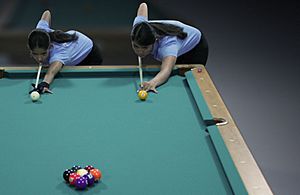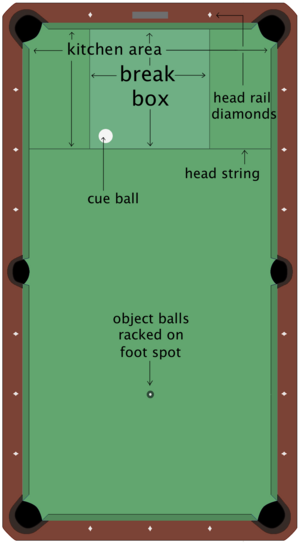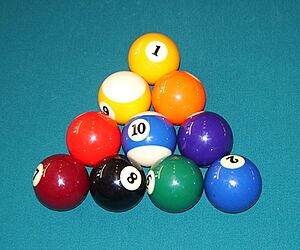Nine-ball facts for kids

The nine-balls being racked: the 1-ball at the apex centered over the foot spot, the 9-ball at center, the other balls placed randomly, and all balls touching
|
|
| Highest governing body | World Pool-Billiard Association |
|---|---|
| First played | 1920s |
| Characteristics | |
| Contact | No |
| Team members | single competitors or doubles |
| Mixed-sex | Yes |
| Equipment | Cue sports equipment |
| Glossary | glossary of cue sports terms |
| Presence | |
| Country or region | Worldwide |
| World Games | 2001 |
Nine-ball (also called 9-ball) is a fun game played on a billiard table with pockets. It's a type of cue sport called pool. This game started in the 1920s in the United States.
To play, you use a long stick called a cue stick to hit a white ball, called the cue ball. Your goal is to hit nine colored balls, numbered 1 through 9, into the pockets. You must always hit the lowest numbered ball on the table first. The game is won when a player successfully pockets the 9-ball.
Nine-ball games are usually played in a "race" to a certain number of wins. For example, the first player to win 7 games wins the whole match. The World Pool-Billiard Association (WPA) sets the rules for the game worldwide. Famous players include Earl Strickland and Shane Van Boening. Nine-ball has even been shown in movies like The Hustler.
While usually played by one person, nine-ball can also be played in teams of two. In doubles, players take turns making shots. Big team tournaments include the World Cup of Pool and the Mosconi Cup.
Contents
History of Nine-ball
Nine-ball became popular in America by the 1920s. No one knows exactly how or where it started. The game uses the same equipment as other pool games, like eight-ball.
How to Play Nine-ball
Nine-ball is played on a pool table with six pockets. You use a white cue ball to hit nine other balls, called object balls. These object balls are numbered 1 to 9 and each has a different color. The 9-ball often has a yellow stripe.
The main goal is to hit the lowest numbered ball on the table first. Then, you try to pocket any of the object balls. As long as you hit the lowest numbered ball first and pocket any ball without making a foul, you keep playing.
If you make a foul or miss pocketing a ball, it's the other player's turn. If you foul, the other player gets to place the cue ball anywhere on the table. This is called ball in hand. The game ends when someone legally pockets the 9-ball. This can happen even if other balls are still on the table, for example, if the 9-ball goes in by hitting another ball first.
Starting the Game: The Break
Each game starts with the object balls placed in a diamond shape. This is called a rack. The 1-ball is at the front, and the 9-ball is in the middle. Players use a triangle or a special diamond-shaped rack to set up the balls.
One player starts by hitting the cue ball into the racked balls. This is called the break. If the 9-ball goes into a pocket on the break, the player wins the game right away! This is sometimes called a golden break.
Sometimes, players decide who breaks first by playing a lag. Both players hit a cue ball down the table, and the one whose ball stops closest to the far end wins the first break. It's possible to win a game of nine-ball without your opponent even getting a shot. This is called a break and run.
Special Shots and Fouls
After the break, if no fouls happened, the player can choose to do a push out. In a push out, you don't have to hit a rail or pocket a ball. After a push out, the other player can choose to take the shot or make you shoot again from the new position. This special rule only applies right after the break.
If a player misses a shot or makes a foul, it's the opponent's turn. Common fouls include:
- Not hitting the lowest numbered ball first.
- Pocketing the cue ball.
- Not hitting a rail with an object ball after hitting the first ball.
If you commit a foul, your opponent gets ball in hand. This means they can place the cue ball anywhere on the table to start their turn. If a player makes three fouls in a row, they lose that game.
Unlike some other pool games, players can jump the cue ball over other balls in nine-ball. However, if any ball leaves the table completely, it's a foul. Many players use a special jump cue for these shots.
European Rule Changes
In Europe, some rules have changed to make the game more challenging. For example, on the Euro Tour, players must break from a special "break box." This makes it harder to pocket the 9-ball on the break. Also, in some tournaments like the Mosconi Cup, the 9-ball is racked at the back instead of the center. This also makes powerful break shots less effective.
Nine-ball Tournaments
The World Pool-Billiard Association (WPA) organizes the biggest nine-ball events around the world. These include championships for men, women, and junior players. Many events are open to anyone who pays an entry fee, while others require players to qualify.
Some of the most important nine-ball tournaments are:
- The WPA World Nine-ball Championship
- The U.S. Open 9-Ball Championship
- The China Open 9-Ball Championship
- The International 9-Ball Open
Other big international competitions include the Mosconi Cup, World Cup of Pool, and World Pool Masters. There are also regional tours like the Euro Tour and the WPA Asian Nine-ball Tour.
Games Like Nine-ball
Nine-ball has inspired other pool games.
- Six-ball: This game is very similar to nine-ball but uses only six balls. The balls are racked in a triangle shape, and the 15-ball is the winning ball.
- Seven-ball: This game uses seven object balls, racked in a hexagon. A key difference is that players must pocket the winning 7-ball into a specific pocket on their side of the table.
- Ten-ball: This is a tougher version of nine-ball. It uses ten balls, and players must "call" (say which pocket they are aiming for) every ball they try to pocket. Also, you cannot win by pocketing the 10-ball on the break shot. Many professional players think ten-ball should become the main professional game because it's more challenging. It even has its own world championship, the WPA World Ten-ball Championship.
See also
 In Spanish: Bola 9 para niños
In Spanish: Bola 9 para niños






